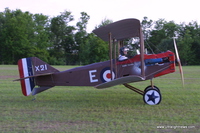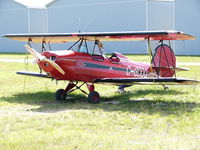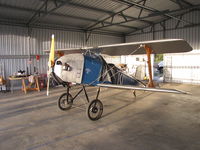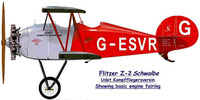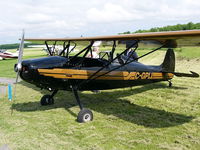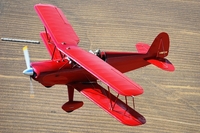Categories: all aviation Building a Biplane bicycle gadgets misc motorcycle theater
Thu, 04 Aug 2016
Building a Biplane: Picking the Model
As I mentioned in the last installment, I'm going to be building a biplane soon. I mentioned that I'd settled on the Marquart Charger as the model I wanted to build, and then coyly mentioned I'd gone through a laundry list of other models without really expanding on the subject.
Welcome to the expansion. I'll go over the various models (as I remember them) and why they appealed to me, but ultimately didn't make the cut.
First, a bit of explanation. An ultralight is an aircraft that can be flown by anyone, with or without a pilot's license, although obviously getting some training is a clever idea. They're very limited, with a low maximum weight limit and other restrictions that make them purely "fun" aircraft with travel potential only a masochist would enjoy. An experimental, in this context, means a plane which falls under the FAA's Experimental Amateur-Built rules, which basically say that you have to build 51% or more of the plane, and it can't be flown commercially. An Experimental Amateur-Built (EAB for short) can otherwise be a huge variety of aircraft, but for the purposes of this discussion, I'll be looking at mostly biplanes capable of carrying two people: pilot and passenger.
The first plane on the list is the Loehle Spad XIII, a kit which can be built as either an ultralight or an experimental. I found it because I searched for ultralights, just kind of wanting to find out more about them, and this was one of the search results. "Right!" I thought, "Biplanes!" I figured if I was going to spend a bunch of time building a plane (which was now percolating in my brain like fireworks), I should build something awesome. I've always liked biplanes, and thus, it began.
The Spad is pretty cool: it looks like one of the important biplanes from WWI, and it could be built as either an ultralight or an experimental. Under experimental rules, it could have a more powerful engine, and would be just generally a more awesome plane. My mind was made up that I was going to build experimental.
However, the Spad has a downfall: only one person. There's no way to lever a passenger in there, and I quickly realized that just like choosing to build a biplane, if I was going to spend all that time building a plane, I better be able to take friends up for rides.
At this point, I kind of went on a biplane research binge, and looked at the huge variety of biplanes I suddenly realized were available to the homebuilder. I rejected a lot of them, finally settling on the Fisher Celebrity.
The Celebrity was my Lieblingsflugzeug for a while, and I researched it intensely, eventually finding a builder who was mid-build, and keeping an active blog. I read the entire thing, fascinated with the process. I even sent him corrections to the weight and balance calculations that he'd published, after he did something simple like forgetting to carry a 1 or something.
My memory of the Celebrity fascination is vague, but I remember really liking that it was powered by a small (100 HP) motor, which meant low fuel consumption. The kit claimed to be easy to build, although I was learning at the time that there's basically nothing easy to build about biplanes, no matter how simple they appear to be. Fisher was claiming some very low build time, like 1000 hours, but internet folk-wisdom was that a biplane always takes 2500-3500 hours, or more if you want to get finicky and detail-oriented.
What ultimately killed it for me was when my builder either finished or got near the end, and ended up horribly disappointed in the actual performance of the plane. It just wasn't enough plane to realistically take two people into the air. 100 HP isn't enough. It can be done, but it will be a slow-poke, and might even be dangerous. And I am not, as you might say, a light guy, so that was pretty much the death knell for the Celebrity as far as I was concerned. There was also something strangely plasticky about the plane that I've never been able to explain, but that's neither here nor there.
The disappointment over the Celebrity left me looking again -- something I'd get to recognize, since it happened over and over and over.
In my latest wave of searching, I came across the Sherwood Ranger. This was many years ago (probably around 2008-2009), so the link you see here is not quite to the same plane I was looking at.
The Ranger had one killer feature that really excited me: folding wings. The wings could be folded back so that you could park your Ranger in a one-car garage, or transport it on a trailer if you wanted. Hangar costs kind of terrified me at this point in time: $300-500 a month, it seemed like an enormous committment, and wouldn't it be cool if I didn't need to have one? So much money saved!
Alas, the Ranger was also without an owner at that time, or at least its ownership was changing. It became obvious as I looked around that the design wasn't really a good choice, simply because its existence seemed to be in question. Without a company backing it, the plans would be unavailable. I also thought seriously about what it would be like to have to tow an airplane to the airport every time I wanted to fly, and spend 30-45 minutes setting up the wings. I'd never do it. The Ranger was off the list.
I was also still on the high-efficiency kick. I looked at the Acrosport II somewhat wistfully, but crossed it off the list as needing too much power. More on the ASII later.
Then, I came across this almost cartoonish looking plane called the Flitzer. It was kind of ugly, but also, kind of... cute? Something. Before I knew it, I was hooked. The cartoonish nature of it was compelling, and it used the venerable VW Bug engine, which could be bought as a kit for a mere $6000 (1/4 the cost of a "real" airplane engine). I subscribed to the mailing list, and was an avid follower for years.
The Flitzer's designer, Lynn Williams (a delightful man who must design airplanes rather than eat or sleep, he's so prolific) also promised a two-place version, the Flitzer Schwalbe, but until just recently, it was always just around the corner, but never quite available. I was pretty sure I'd build a Schwalbe. I didn't love the higher wing as much (the super tight upper wing really appeals to me for no reason I can pin down), but hey, it would carry two people!
One of the very appealing things about the Flitzer is that it's made entirely of wood. There are a handful of metal fittings in the plane, and the landing gear and motor mount, but the rest is just wood and fabric. That was very appealing to me, since I didn't know how to weld, and found that to be a daunting prospect. Most biplanes of this size are built of steel tube for the fuselage, and wood for the wings.
But then, one day (actually quite recently, less than a year ago), I looked at the weight numbers on the Flitzer Schwalbe, and realized the problem: although it would fit two people, the weight limits meant that with full fuel, I could take up a ~60 lb passenger. I only know one person under 60 lbs, but he's 9, and he's going to be above that weight well before I could get anything built. Even reducing to half fuel didn't help much, since the plane only carries about 13 gallons (6 lbs per gallon of fuel filled). And there's no way I could take my parents or some of my more me-sized friends even with no fuel.
It was with profound sadness that I crossed the Flitzer Schwalbe off the list.
That left me, honestly, feeling a bit adrift. I had been thinking "Flitzer!" for so long that it was hard to shift my brain around to anything else. However, I rallied, and started looking around. Interestingly, it wasn't a biplane that next caught my attention, but rather a parasol monoplane -- a plane that just has one wing, but has it up on struts so that it looks like a biplane with the bottom wing missing: the Bakeng Deuce.
The Deuce appealed to me for reasons that aren't as clear now, looking back on them, but I liked it for whatever reason. (If it isn't clear by now, what draws me to these various planes is clearly based on emotions to such an extent that I can't actually explain some of my choices.) It carried two people, looked interesting and different (there are actually a lot of biplanes out there, but relatively few parasol designs in the air). I think this was when I was suddenly looking at payload capacity, and the Deuce delivered on that, with 600 lbs payload. I would definitely be able to take up myself, my heavy friend, and enough fuel to do interesting things. Not much else, but that's what mattered.
However, as I looked more into it, it became apparent that the Deuce was essentially a moribund design, from a support standpoint. There is still an "active" forum online, but I use that term reservedly: I made a post there, and there was only ever one person who responded (the designer), and he was so discouraging that I felt like it was a bad choice. He was being intentionally discouraging to weed out frivolous people, which I am not, and I understood that as I was reading it, but it still left me with a bad taste in my mouth and I decided I'd rather find something with a bit more of a community around it. I also couldn't find any Deuces anywhere nearby to go visit, which ended up being a big turn-off.
This was roughly when I started looking again at the "big" two-place biplanes. These are, in no particular order, the aforementioned Acrosport II, the Hatz Classic, the Stolp Starduster Too, the Steen Skybolt, and a number more. The ASII was appealing in part because I'd looked into it pretty thoroughly a few years earlier, and everything I'd read sounded right. It's a docile handling plane that can work as an acrobatic trainer, but isn't twitchy and hard to land. It can definitely carry two people. It is actually physically large enough to fit me. There's a huge support community, with numerous active builders. I could see numerous examples nearby if I wanted to.
That list of attributes can actually be applied to every plane I listed there. They all look good on paper, but for one thing: I don't much like the way they look. That thing I mentioned earlier, about emotion and non-rational decisions? It keeps me away from this long list of otherwise ideal projects. It's kind of a pity, really.
Actually, I should provide some detail: the Hatz Classic is a gorgeous plane, particularly with that lovely (and expensive, but that's for the next installment) Rotec radial mounted on the nose. It would be a good choice, and was basically riding in a tie for first place with the Marquart Charger for The Plane I Want To Build.
The Classic has a strong positive, and a strong negative to balance each other out. Sort of. The fact that it comes with plans already drawn for the installation of the radial engine is a huge plus. However, the negative is that the front seat, by all reports, requires that the passenger be a contortionist to actually get in. Many of the people I'd like to take into the skies with me are not contortionists. Some are very far from any hint of contortionism. So, that's a huge negative for my purposes.
The death knell for the Classic came when I tried to inquire about ordering the evaluation plans offered by the company that nominally sells them: I never heard back. I'd read about this, but wasn't sure what my experience would be. Sure enough, my attempts to reach them were completely ignored, or never even arrived in the first place. The company selling the plans appears to have no interest in actually, you know, selling the plans. Without plans to look at, there's little I can do. I crossed the Classic off the list.
This is where the Charger (what I think will be my actual, real, it's-actually-happening project) really wins: the plans are free. Plan cost isn't a big deal -- it's a $50,000-75,000 project, who cares if the plans are zero dollars or $350? But because they're public domain, they're available. I downloaded a set and had them printed out full-size. It cost $75 from a local print shop. I have PDFs on every computer around me, so I can refer to them any time I want to.
However, in addition to that, the Charger is described in print and in person as being a delight to fly. A "pilot's airplane." One which can go up and do acrobatics if you want, but isn't really intended for that. One which will hold enough weight to take me and a friend up. A plane that, importantly, looks good to me, with those swept wings and long tail.
It's not perfect. There's no one building now, so the pool of people with direct experience is slim to none. However, the Charger is also sufficiently like all the other planes of very similar design that only super type-specific questions will be hard to answer. The landing gear is in need of reinforcement as-drawn, so some engineering brainpower is going to have to go into that. It doesn't have a radial engine installation all planned out and ready to go (this might be a blessing in disguise, but again, that's for the next episode).
But, for its faults and its highlights, the Charger is the plane I've already got 10.4 build hours logged on, all spent with a CAD program, re-creating little metal brackets and fittings so they can be sent to a waterjet shop and cut out exactly right. I've begun learning how to weld. The garage will start construction soon, and I'll finally, finally have a place to build this project that's been bounding around inside my brain for the last decade.
Posted at 23:02 permanent link category: /charger
Categories: all aviation Building a Biplane bicycle gadgets misc motorcycle theater
